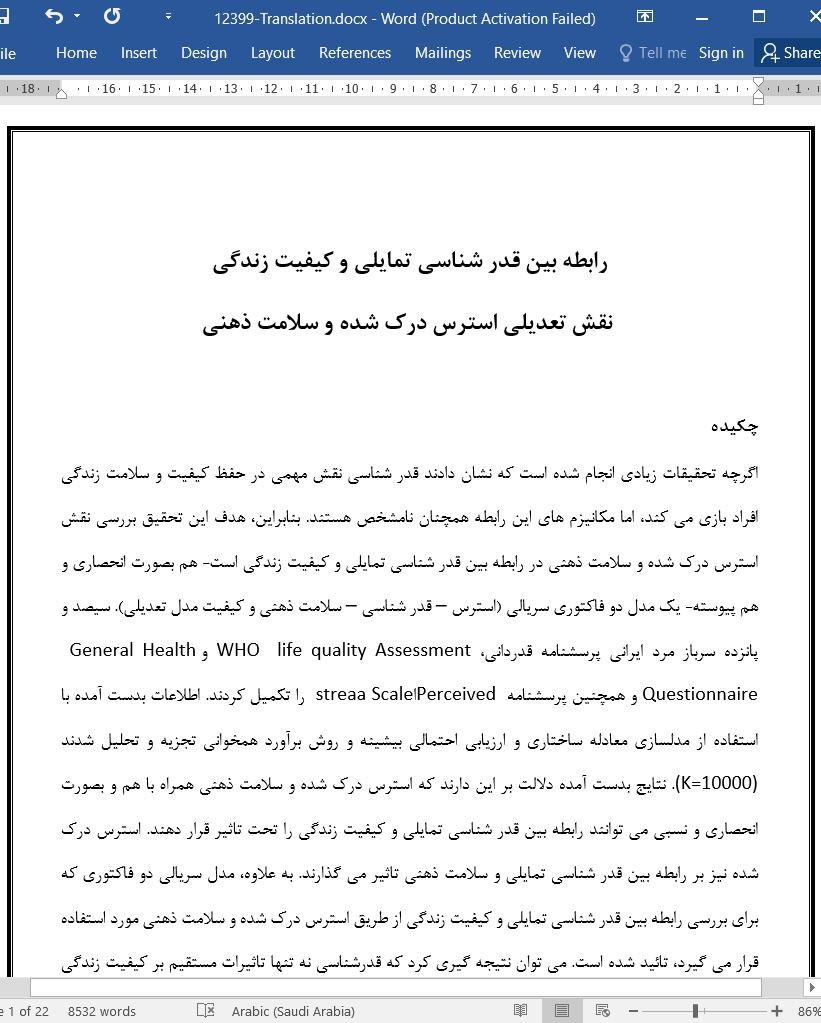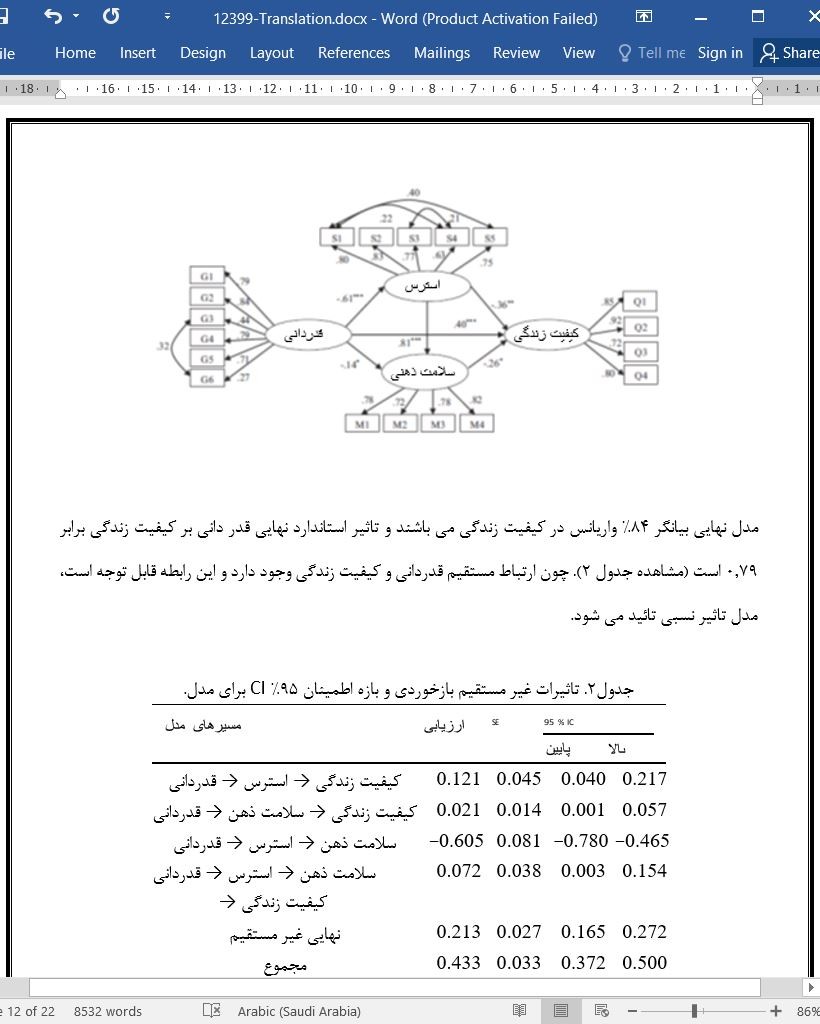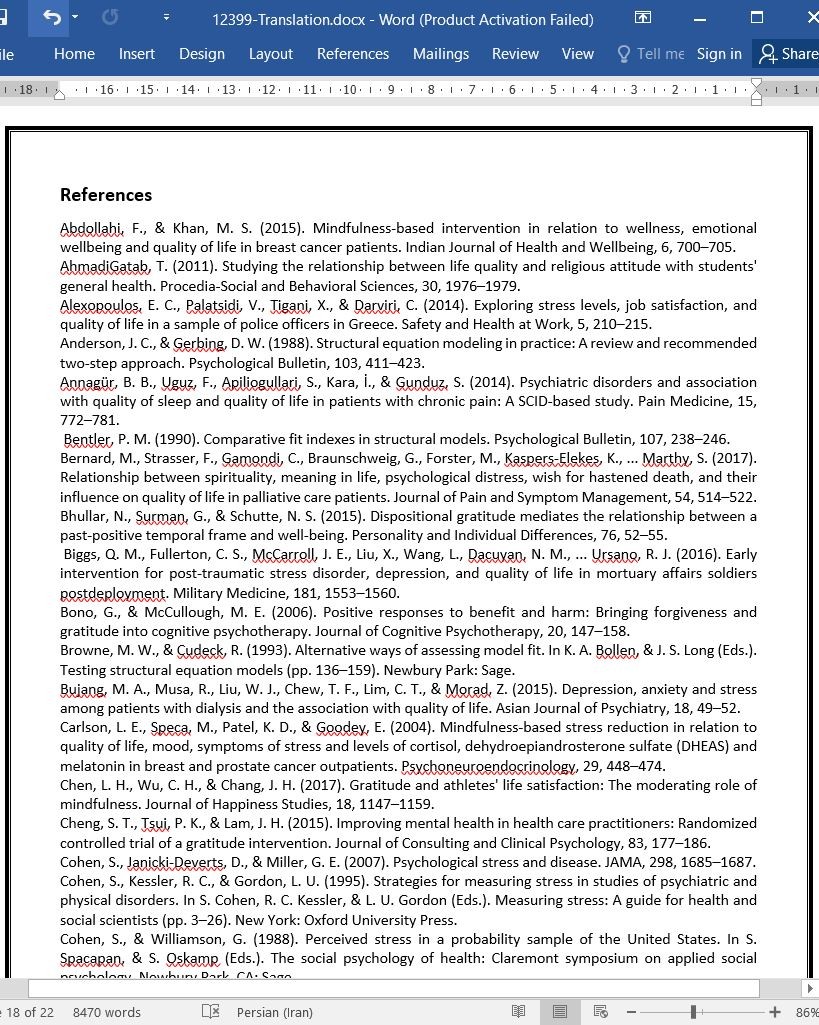
رابطه بین قدر شناسی تمایلی و کیفیت زندگی: نقش تعدیلی استرس درک شده و سلامت ذهنی
چکیده
اگرچه تحقیقات زیادی انجام شده است که نشان دادند قدر شناسی نقش مهمی در حفظ کیفیت و سلامت زندگی افراد بازی می کند، اما مکانیزم های این رابطه همچنان نامشخص هستند. بنابراین، هدف این تحقیق بررسی نقش استرس درک شده و سلامت ذهنی در رابطه بین قدر شناسی تمایلی و کیفیت زندگی است- هم بصورت انحصاری و هم پیوسته- یک مدل دو فاکتوری سریالی (استرس – قدر شناسی – سلامت ذهنی و کیفیت مدل تعدیلی). سیصد و پانزده سرباز مرد ایرانی پرسشنامه قدردانی، WHO life quality Assessment و General Health Questionnaire و همچنین پرسشنامه Perceived ا streaa Scale را تکمیل کردند. اطلاعات بدست آمده با استفاده از مدلسازی معادله ساختاری و ارزیابی احتمالی بیشینه و روش برآورد همخوانی تجزیه و تحلیل شدند (K=10000). نتایج بدست آمده دلالت بر این دارند که استرس درک شده و سلامت ذهنی همراه با هم و بصورت انحصاری و نسبی می توانند رابطه بین قدر شناسی تمایلی و کیفیت زندگی را تحت تاثیر قرار دهند. استرس درک شده نیز بر رابطه بین قدر شناسی تمایلی و سلامت ذهنی تاثیر می گذارند. به علاوه، مدل سریالی دو فاکتوری که برای بررسی رابطه بین قدر شناسی تمایلی و کیفیت زندگی از طریق استرس درک شده و سلامت ذهنی مورد استفاده قرار می گیرد، تائید شده است. می توان نتیجه گیری کرد که قدرشناسی نه تنها تاثیرات مستقیم بر کیفیت زندگی دارد، بلکه تاثیرات غیر مستقیم از طریق استرس درک شده و سلامت ذهنی دارد.
1. مقدمه
1.1 قدر شناسی و بازده آن
قدر شناسی می تواند به عنوان عادتی تعریفی شود که تاکید آن بر قدر دانی از ویژگی ها و خصلت های مثبت زندگی می باشد (وان دوسن ، تیانیو، کاشدان & الهای 2015، وود ، قراه & گراگتی 2010). قدر شناسی یکی از ویژگیهای روانشناسی مثبت در نظر گرفته می شود که جهت گیری آن به سمت خصلت های مثبت در جهان است (وود ، مالتبی ، گیات، لینلی & جوزف 2008).
از نظر مفهومی، قدر شناسی باید منجر به ارتقای سلامت شود (وود، جوزف& مالتبی 2008). در دو دهه گذشته، شواهد زیادی یافت شده است که بیان کرده اند که قدر شناسی رابطه منفی با نگرانی عمومی (مک کالوگ، امونس & تسانگ 2002)، افسردگی (لین 2015، تالبور 2015)، عواطف منفی (لیتون ، بردلی & موریسوی، تالبور2015)، رفتارهای پر خطر (ما، کیبلر & اسلی 2013)، تمایل به خود کشی (استاکتون ،تاکر، کلیمن & وینگات 2016)، علائم PTSD (وان دانسن و همکاران 2015) و شخصیت عصبی (وود جوزف، مالتبی 2008) دارد و این رابطه با سلامت های مربوطه از جمله سلامت فیزیکی بهتر (هیل، آلماند& رابرتز 2013)، رضایت از زندگی (چن، وو، چانگ 2017، اسزسنیاک & سورس 2011)، عواطف مثبت (لیتون و همکاران 2014)، امید و رشد فردی (لو ، تسای، رایلو & اویی 2014)، بخشندگی (لیتون و همکاران 2014)، اعتماد به نفس (لین 2015)، کیفیت خواب (وود، جوزف ،لیولد & آتکینس2009)، خود کارایی (میلس و همکاران 2015)، سرزندگی و خوشحالی فردی و سلامت روانشناسی (بهولر، سرمن، اسموت 2015، لین 2016) مثبت است.
Abstract
Even though there is a great deal of research showing that being grateful plays an important role in maintaining one's quality of life and well-being, the mechanisms of this relationship remain unclear. Therefore, the aim of the current study was to investigate the role of perceived stress and mental health in the relationship between dispositional gratitude and quality of life, both uniquely and in-sequence (a serial two-mediator model: gratitude-stress-mental health-quality of life mediation model). Three-hundred and fifteen male Iranian soldiers completed the Gratitude Questionnaire, the WHO Quality of Life Assessment, the General Health Questionnaire, and the Perceived Stress Scale. The data were analyzed by Structural Equation Modeling using the maximum likelihood estimation and Bootstrap estimation method (k = 10,000). The results indicated that perceived stress and mental health, together and uniquely, partially mediated the relationship between dispositional gratitude and quality of life. Perceived stress also mediated the relationship between gratitude and mental health. Moreover, the serial two-mediator model which was used to examine the relationship between gratitude and quality of life through perceived stress and mental health, in sequence, was supported. It can be concluded that gratitude not only has direct effects on quality of life, but also has indirect effects through perceived stress and mental health.
1. Introduction
1.1. Gratitude and its outcomes
Gratitude can be defined as a habitual focusing on and appreciating the positive aspects of life (Van Dusen, Tiamiyu, Kashdan, & Elhai, 2015; Wood, Froh, & Geraghty, 2010). Gratitude is considered a positive psychological trait, being an orientation towards the positive aspects in the world (Wood, Maltby, Gillett, Linley, & Joseph, 2008).
Conceptually, gratitude should be expected to lead to improved well-being (Wood, Joseph, & Maltby, 2008). In the last two decades, a large body of evidence has found that gratitude is negatively associated with general anxiety (McCullough, Emmons, & Tsang, 2002), depression (Lin, 2015; Tulbure, 2015), negative affect (Eaton, Bradley, & Morrissey, 2014), high-risk behaviors (Ma, Kibler, & Sly, 2013), suicide ideation (Stockton, Tucker, Kleiman, & Wingate, 2016), PTSD symptoms (Van Dusen et al., 2015), and neuroticism personality (Wood, Joseph, & Maltby, 2008), and gratitude positively related to well-being, including better physical health (Hill, Allemand, & Roberts, 2013), life satisfaction (Chen, Wu, & Chang, 2017; Szcześniak & Soares, 2011), positive affect (Eaton et al., 2014), hope and personal growth (Loo, Tsai, Raylu, & Oei, 2014), forgiveness (Eaton et al., 2014), self-esteem (Lin, 2015), quality of sleep (Wood, Joseph, Lloyd, & Atkins, 2009), self-efficacy (Mills et al., 2015), vitality and subjective happiness (McCullough et al., 2002), and subjective well-being and psychological well-being (Bhullar, Surman, & Schutte, 2015; Lin, 2016).
چکیده
1. مقدمه
1.1 قدر شناسی و بازده آن
1.2 استرس به عنوان مکانیزمی که از طریق آن قدرشناسی با بازده سلامت مرتبط می شود
1.3 استرس، سلامت ذهنی، و کیفیت زندگی
1.4 تحقیق کنونی
2. روش ها
2.1 شرکت کنندگان و روش ها
2.2 شاخص های اندازه گیری
2.2.1 پرسشنامه قدر دانی (GQ-6)
2.2.2 پرسشنامه WHO کیفیت زندگی Assessment (WHOQOL-BREF)
2.2.3 پرسشنامه General Health Questionnaire (GHQ-12)
2.2.4 پرسشنامه Perceived استرس Scale (PSS-10)
2.3 تحلیل آماری
3.نتایج
3.1 تحلیل همبستگی
3.2 مدل اندازه گیری
3.3 مدل ساختاری
4. بحث
منابع
ABSTRACT
1. Introduction
1.1. Gratitude and its outcomes
1.2. Stress as a mechanism through which gratitude relates to health outcomes
1.3. Stress, mental health, and quality of life
1.4. The current study
2. Methods
2.1. Participants and procedures
2.2. Measures
2.2.1. Gratitude Questionnaire (GQ-6)
2.2.2. WHO Quality of Life Assessment (WHOQOL-BREF)
2.2.3. General Health Questionnaire (GHQ-12)
2.2.4. Perceived Stress Scale (PSS-10)
2.3. Statistical analyses
3. Results
3.1. Correlational analysis
3.2. Measurement model
3.3. Structural model
4. Discussion
References
- اصل مقاله انگلیسی با فرمت ورد (word) با قابلیت ویرایش
- ترجمه فارسی مقاله با فرمت ورد (word) با قابلیت ویرایش، بدون آرم سایت ای ترجمه
- ترجمه فارسی مقاله با فرمت pdf، بدون آرم سایت ای ترجمه



